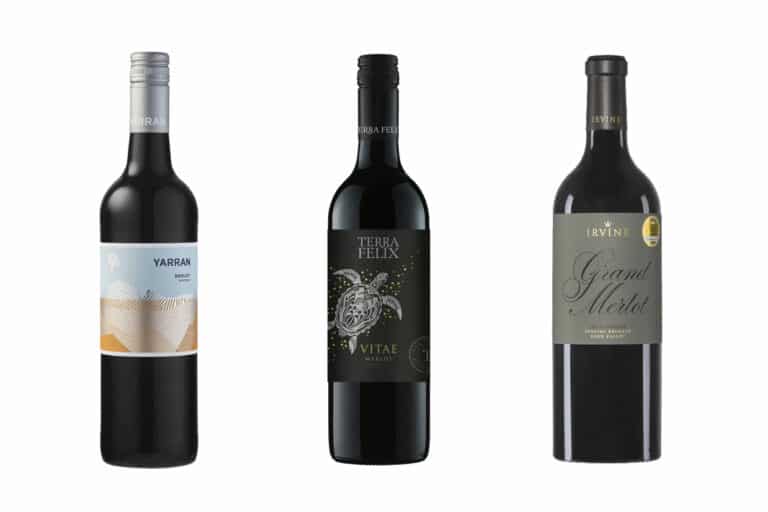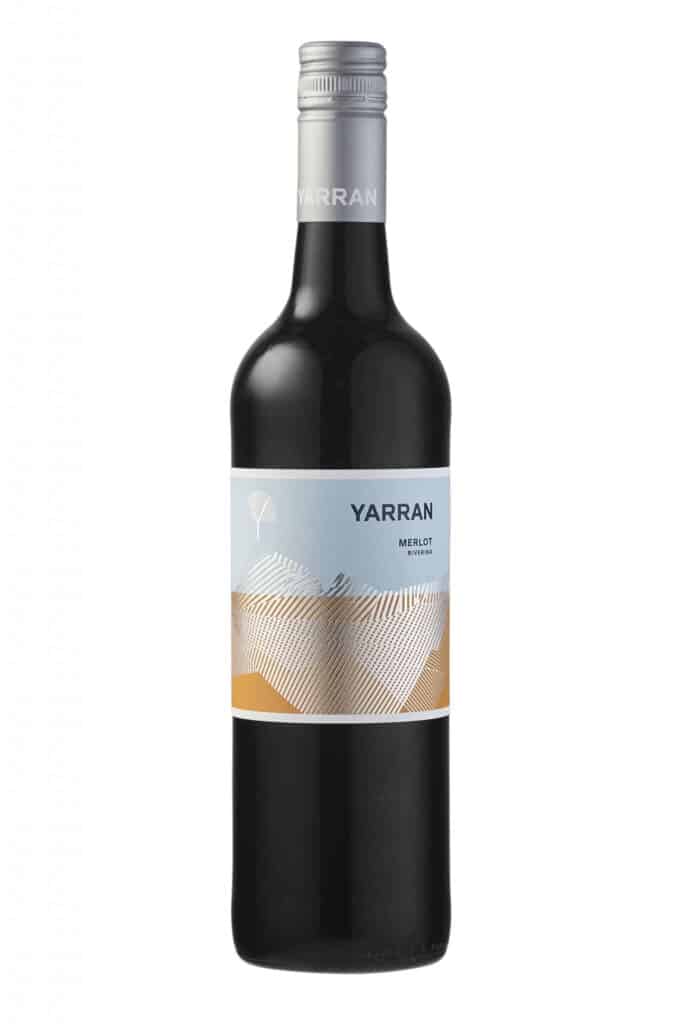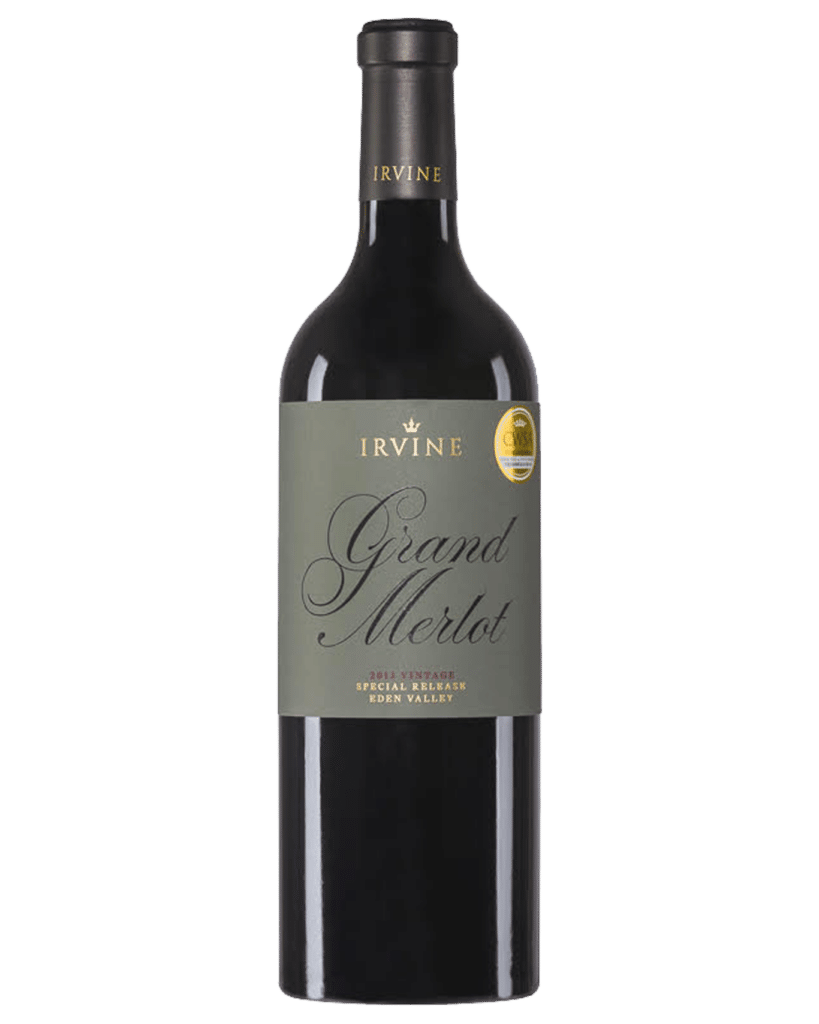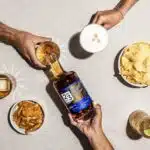WINE
MERLO ME # MERLO ME! Don’t look Sideways – aim straight for the Merlo section in your wine store

WORDS: Peter Panousis - Peter Pan Wines PHOTOGRAPHY Supplied
Nearly twenty years ago the “black comedy” movie Sideways (which was nominated for five Academy Awards) is generally credited for propelling Pinot Noir sales in the United States. The movie follows two middle-aged friends — one a school teacher and so-called wine snob named Miles played by Paul Giamatti; the other, Miles’ best mate named Jack played by Thomas Haden Church, a soon-to-be married actor on a week-long road trip through Californian wine country. Miles clearly enjoys Pinot Noir and makes a point of espousing the variety’s virtues in all his wine-sniffing, pontificating ways. Conversely, however, the movie was also responsible for causing the massive decline in Merlot sales in the USA as Miles savaged the variety on screen.
I remember giggling at one scene where Miles is about to enter a restaurant and he snaps “If anyone orders Merlot, I’m leaving. I’m not drinking any f$&king Merlot.” And there begins the journey of Merlot’s decline. The real irony of the movie however is Miles’ most prized wine possession is a bottle of 1961 Cheval Blanc, a Bordeaux made from Merlot and Cabernet Franc (and a bloody great year for Bordeaux too I might add). So I say ha, ha, ha to him, he got it wrong! Merlot is delicious and besides, one of the most expensive wines in the world is Chateau Petrus, a wine made almost entirely of Merlot. So if you have been avoiding Merlot over the past 20 years fear not, it’s time to drink up!
What is Merlot?
According to many wine literature sources, Merlot is the second most widely planted grape variety around the world. It is thin-skinned, dark blue in appearance and is easily identified by loose bunches of large dark berries.
The origins of the grape can be traced back to around the 1700’s in the southwest area of France known as Bordeaux. The name Merlot is derived from the word merle or merlau, which were local dialectical words to describe blackbirds in the region. Merlot quickly began to gain popularity, and winemakers began widely planting the grape many referred to as “little blackbird” or “young blackbird” in the Bordeaux region. No one is quite sure if the name is a reference to the dark skin of the grape or to the blackbirds that have a fondness for eating the grapes off the vine.
Merlot is often described as lush, silky, smooth and less aggressive than sibling Cabernet Sauvignon. On the nose think Christmas cake in a glass with notes of plum, cherry, chocolate, mocha, vanilla, sage, anise and violets covering some of the spectrum. On the palate, Merlot is medium-bodied, fruit-forward, moderate acidity with low to medium tannins. It is often added to Cabernet Sauvignon and other varieties to both soften and fill the middle palate. Age-worthy, Merlot will keep perhaps as long as Pinot Noir but not to the extent of expensive Cabernet Sauvignon.
Where does Merlot grow best?
Merlot grows well around the world but in particular Bordeaux, Tuscany, North-Eastern Italy, Chile, Argentina, California, and our neighbours over the ditch Hawkes Bay, New Zealand just to name a few prominent regions. Here in Australia Merlot grows best in Coonawarra, Margaret River, Eden Valley, Barossa Valley, McLaren Vale and many parts of Victoria, but one can find it growing over many of our wine regions.
Merlot grows best in free-draining soils or hillsides as it doesn’t like wet feet and over-ripening can occur, thus increasing sugar levels if not managed correctly in the vineyard. Sandy soils also contribute to Merlot’s softer side. Here, Merlot has origins in the mid-1920’s rather than the early beginning of the 1800’s. Specifically, Merlot really didn’t get going until the 1960’s. Figures from James Halliday’s Wine Companion 2018 indicate that Merlot is Australia’s 4th largest crush, just behind Cabernet Sauvignon but just in front of Sauvignon Blanc.
It should be noted that like most grape varieties, when it comes to Merlot the difference between old world (wines made in Italy, France, Greece, Spain, etc.) and new world wines (Australia, New Zealand, South Africa, USA) are easily recognisable. For example, old-world winemakers choose to pick their Merlot grapes on the earlier side of harvest to keep alcohol content low (making the wine more medium-bodied) and to protect a little natural acidity. New World producers/winemakers, by comparison, tend to prefer picking later in the season, creating a fruity, full-bodied Merlot that stands alone as a single-varietal wine. Further, Merlot is a hearty varietal that straddles both cool and warm climates. Cool-climate merlot, like that coming out of the Bordeaux Right Bank, is often mistaken for Cabernet Sauvignon. It’s structured and tannic with hits of tobacco and tar, making for an earthy glass of red. In contrast, warm-climate Merlot is much more fruit-forward. In warmer climates, producers will often settle their Merlot in oak for up to 24 months in an effort to develop more character and structure.
Why Merlot?
Merlot can be made in a number of styles ranging from the light, quaffable and affordable, to the bold, rich, and expensive. Therefore, Merlot suits a number of wine drinkers ranging from the most discerning palates to budgets and first-timer beginners. The variety is approachable and suits those who are new to red wine drinking, primarily because of Merlot’s moderate acidity and low to medium tannins. Consequently, Merlot can be paired well with simple foods like burgers, pasta, pizza and foods rich in tomato-based sauces. Yet, it can marry well with fish like salmon and shellfish but it particularly works well with meats like beef, venison, lamb, pork and duck. Cheese and red wine is always a bit questionable but sharp cheese and Merlot is such a winning combination. And ever tried Merlot and chocolate? It works too!
What to consider……
Perhaps Australia’s most Iconic and expensive Merlot is James Irvine’s Grand Merlot. James’ property was established in 1983 with some 400 acres of land, thus making it one of the largest privately owned premium vineyards in the Barossa and Eden Valleys. Even though James owns some of the oldest and finest plantings of Shiraz and Riesling, Merlot won his heart and became a key focus. The story goes that James fell in love with Merlot after trying Chateau Petrus twice in the one year many years ago. That was all James needed to produce arguably Australia’s best Merlot and at $150 direct from the vineyard, I see why. The Grand Merlot site is 23 acres and the vines are grown on sandy loam over gravel soil. Up to seven clones of Merlot are used to make the wine, but not always with every vintage. In addition, this wine has won two world championships over the years for World’s Best Merlot. On both the nose and palate the wine shows plum, blueberries, fig, five spice and dark chocolate. The wine is opulent, complex, silky and smooth. A must pairing with a good rib eye or sirloin steak.
From Coonawarra, I have always admired Katnook Estate Merlot from the rich Terra Rossa soils of the region. Coonawarra is classified as cool climate and is home to some of the best Cabernet Sauvignon and Merlot in Australia. Katnook was established in the late 1890’s by John Riddoch, a wine pioneer. The property is approximately 490 acres or about 200 hectares in size and is owned by the Wingara Group, a Spanish company that also owns Freixenet the Spanish Cava. The first commercial vintage by Katnook was made in 1980 by winemaker Wayne Stehbens in the ‘Katnook’ woolshed, just as Riddoch had done 84 years earlier. When Wayne passed away in 2017, he was one of the longest-serving and most successful winemakers to have worked for one winery in Australian wine history. Katnook has two wines in the prestigious Langton’s Classification of Australian Wines, two Jimmy Watson trophies and a five-star rating in James Halliday’s Wine Companion 2020. Their Katnook Merlot is complex with layers of dark fruits, hints of chocolate, earthy and a lovely line of vanilla, soft and silky to the finish. Aged for 22 months in French oak it is medium-bodied and a pure delight to the senses. A must with rib eye or wagyu beef grilled to perfection!
Next on the to-try list is Yarran’s Merlot. The Yarran Winery is located on the outskirts of Yenda in the Riverina about 16 kilometres from the town of Griffith and is named after the beautiful native trees (acacia) which have generous canopies of feathery leaves. The winery was voted James Halliday’s Dark Horse Winery of the Year in 2021. Yarran is approximately 30 hectares under vine, growing several grape varieties such as Pinot Grigio, Sauvignon Blanc, Chardonnay, Shiraz, Cabernet, Merlot, Durif just to name a few. The Yarran cellar door overlooks the Cocoparra National Parkland and is cosy and inviting. In 2021 the cellar door was named ‘Best Cellar Door’ Riverina by Gourmet Traveller Wine and ‘The Must Visit’ winery by Escape Magazine.
Their Merlot is well made showing notes of dark plum, vanilla and cedar most likely from the short time in oak, while the palate is opulent, silky and smooth. A juicy delicious wine, with plenty of appeal to both new and seasoned wine drinkers. A must-try wine with slow-cooked beef cheeks served on creamy polenta.
Finally, try the Terra Felix Vitae Merlot. The Terra Felix winery was established in 2001 and the name Terra Felix means the ‘lucky country’. The owner-operator is Peter Simon and his father established the winery after migrating from Austria. In 2019, James Halliday awarded the winery 5 black stars. The main aim of Terra Felix is to create exceptional, affordable wines from Australia’s premium wine regions by selecting the “Best Fruit” from outstanding vintages.
The Terra Felix Vitae Merlot is a medium-bodied wine with enticing varietal characters of luscious black cherry, plums and sweet violets. Vibrant red berry fruits and dried rosemary nuances are framed by fine tannins and subtle mocha notes to a long finish. The wine has received 91 points from Wine Showcase Magazine and will pair particularly well with spaghetti bolognese, burgers and pizza.
What more can I say…….Merlot Me #MerlotMe! And enjoy happy, safe drinking.
Peter Panousis is a Fine Wine Consultant who has worked for leading wine companies for over 17 years. Raised on the Gold Coast Peter has operated many restaurants and cafes and is formally educated with a Degree in Hospitality Management, and he eventually owned two award-winning restaurants. Peter has completed a Master’s degree and a Certificate IV in Adult Training. In wine, Peter is WSET trained and certified and has undertaken extensive wine education courses. He is also a former Member of ASVO (The Australian Society of Viticulture and Oenology), and a former Associate Fellow of AIM (Australian Institute of Management).












